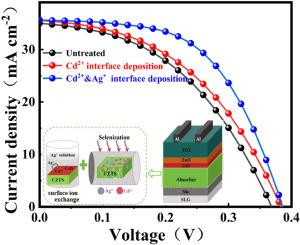通过 Cd2+&Ag+ 双离子界面沉积减少 Cu2ZnSn(S,Se)4 太阳能电池中的界面缺陷
IF 6.3
2区 材料科学
Q2 ENERGY & FUELS
引用次数: 0
摘要
钾长石铜2锌锡(S,Se)4(CZTSSe)薄膜太阳能电池因其丰富的元素保留和优异的光伏性能而被认为是一种前景广阔的新型薄膜电池。然而,异质结界面上的有害缺陷严重阻碍了电荷传输、分离和提取,极大地限制了 CZTSSe 太阳能电池的光伏性能。本研究提出了一种在异质结界面加入 Cd2+ 和 Ag + 双离子的简单方法,以减少界面缺陷。结果表明,Cd2+和Ag+双离子界面沉积有效地减少了异质结界面附近的[2Cuzn + Snzn]有害缺陷,从而减少了界面中的重组中心数量。这就改善了界面上的载流子重组。同时,器件实现了更宽的耗尽宽度,更有利于载流子收集。最终,转换效率提高了 32.81%。这种简单的界面双离子沉积策略为进一步提高 CZTSSe 电池的效率提供了一种前景广阔的策略。本文章由计算机程序翻译,如有差异,请以英文原文为准。

Decreased interface defects in Cu2ZnSn(S,Se)4 solar cells via Cd2+&Ag+ double-ion interface deposition
Kesterite Cu2ZnSn(S,Se)4 (CZTSSe) thin film solar cells are considered a promising new type of film cell, due to their rich elemental reservation and excellent photovoltaic performance. However, the deleterious defects at the heterojunction interface severely hinder charge transport, separation, and extraction, significantly limiting the photovoltaic performance of CZTSSe solar cells. In this study, a simple method involving the incorporation of Cd2+ and Ag + dual-ion at the heterojunction interface was proposed to reduce interfacial defects. The results showed that Cd2+ and Ag + dual-ion interface deposition effectively reduced the [2Cuzn + Snzn] harmful defects near the heterojunction interface and subsequently reduced the number of recombination centers in the interface. This led to improved carrier recombination at the interface. Meanwhile, the devices achieved a wider depletion width, which was more favorable for carrier collection. Ultimately, the conversion efficiency increased by 32.81 %. This simple interface dual-ion deposition strategy offers a promising strategy for further enhancing the efficiency of CZTSSe cells.
求助全文
通过发布文献求助,成功后即可免费获取论文全文。
去求助
来源期刊

Solar Energy Materials and Solar Cells
工程技术-材料科学:综合
CiteScore
12.60
自引率
11.60%
发文量
513
审稿时长
47 days
期刊介绍:
Solar Energy Materials & Solar Cells is intended as a vehicle for the dissemination of research results on materials science and technology related to photovoltaic, photothermal and photoelectrochemical solar energy conversion. Materials science is taken in the broadest possible sense and encompasses physics, chemistry, optics, materials fabrication and analysis for all types of materials.
 求助内容:
求助内容: 应助结果提醒方式:
应助结果提醒方式:


